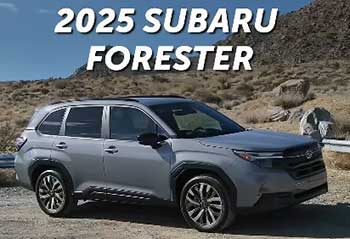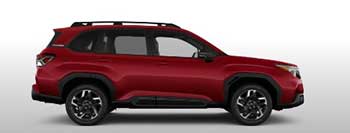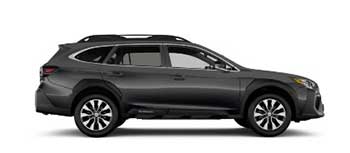
I’ve always been drawn to Subaru’s rugged charm, and choosing between the Forester and Outback felt like picking a favorite adventure buddy.
Both are stellar SUVs, packed with all-wheel drive, safety tech, and outdoor-ready vibes, but they cater to slightly different lifestyles.
In this article, I’ll share my firsthand experience driving both, breaking down their pros, cons, and key features to help you decide which fits your needs.
Whether you’re a city commuter or a trailblazer, I’ll guide you through their differences with a detailed comparison, maintenance tips, and answers to common questions.
Comparison Table
| Feature | Subaru Forester (2025) | Subaru Outback (2025) |
|---|---|---|
| Body Style | Compact SUV | Midsize Wagon/Crossover |
| Base Price | $32,028 | $29,584 |
| Engine Options | 2.5L Flat-4 (180 hp) | 2.5L Flat-4 (182 hp), 2.4L Turbo (260 hp) |
| Ground Clearance | 8.7 in (9.2 in Wilderness) | 8.7 in (9.5 in Wilderness) |
| Cargo Space | 28.9 cu ft (74.4 cu ft folded) | 32.6 cu ft (75.6 cu ft folded) |
| Passenger Volume | 110.8 cu ft | 109 cu ft |
| Towing Capacity | 1,500 lbs | 3,500 lbs (turbo models) |
| Fuel Economy | 26/33 mpg (city/highway) | 26/33 mpg (base), 23/30 mpg (turbo) |
| Infotainment | 8-inch touchscreen (standard) | 11.6-inch touchscreen (optional) |
| Reliability (J.D. Power) | 83/100 | 80/100 |
My Experience With Subaru Forester
Driving the 2025 Subaru Forester felt like slipping into a reliable, no-nonsense companion for daily life and weekend escapes. Its boxy, upright design gives it a commanding view of the road, which I appreciated while navigating crowded city streets.
The compact SUV vibe makes it nimble, especially when parallel parking or weaving through traffic. On a recent trip to a nearby state park, the Forester’s 8.7-inch ground clearance (9.2 inches in the Wilderness trim) handled gravel paths and light off-roading with ease. The standard Symmetrical All-Wheel Drive gripped the terrain confidently, even when the trail got muddy after a rain.
Inside, the Forester’s cabin is practical and spacious, offering 110.8 cubic feet of passenger room. I found the seats comfortable for long drives, and the 28.9 cubic feet of cargo space easily swallowed my camping gear. Folding the rear seats gave me 74.4 cubic feet, perfect for bulkier items like a cooler or my dog’s crate.
The 8-inch touchscreen infotainment system was intuitive, with Apple CarPlay and Android Auto making navigation a breeze. However, the base 2.5-liter engine, pumping out 180 horsepower, felt adequate but not thrilling, especially on highways where I craved more pep.
Safety is where the Forester shines. Subaru’s EyeSight suite, standard across all trims, includes adaptive cruise control, lane-keep assist, and automatic emergency braking. During my test drive, the lane-keep assist gently nudged me back when I drifted, and the adaptive cruise made highway commutes less stressful.
The Forester’s five-star NHTSA rating and 2023 IIHS Top Safety Pick award gave me confidence, especially when driving with family.
Overall, the Forester feels like a versatile, budget-friendly choice for those who want a compact SUV that’s equally at home in urban jungles or on light off-road adventures. It’s not flashy, but it gets the job done with Subaru’s signature reliability.
My Experience With Subaru Outback
The 2025 Subaru Outback, with its wagon-like silhouette, felt like a more refined, adventurous cousin to the Forester. Its longer, sleeker body—191.9 inches compared to the Forester’s 183.3—gave it a smoother ride on highways, soaking up bumps with its longer wheelbase.
I took it on a weekend road trip, and the Outback’s 8.7-inch ground clearance (9.5 inches in the Wilderness trim) tackled dirt roads and rocky trails without breaking a sweat. The available 2.4-liter turbocharged engine, delivering 260 horsepower, was a game-changer for passing slower vehicles or climbing steep hills.
The Outback’s interior felt a touch more upscale, with options like Nappa leather and ventilated seats on higher trims. The 11.6-inch touchscreen (optional) was a standout, offering crisp graphics and seamless smartphone integration.
With 109 cubic feet of passenger space, it’s slightly less roomy than the Forester, but the 32.6 cubic feet of cargo space (75.6 cubic feet folded) easily fit my bikes without removing the wheels. The Outback’s towing capacity, up to 3,500 pounds with the turbo engine, made it a better pick for hauling heavier gear.
Safety-wise, the Outback matches the Forester’s prowess with the same EyeSight suite and a 2024 IIHS Top Safety Pick rating. I noticed the Outback’s ride was quieter, thanks to extra sound insulation, which made long drives more relaxing. However, its higher price tag, especially for turbo models, gave me pause, and the base engine felt similar to the Forester’s in terms of power.
The Outback suits those who want a versatile, slightly more luxurious ride with extra towing power and off-road capability, perfect for long road trips or rugged adventures.
Pros Of Subaru Forester

- Affordable Starting Price: At $32,028, the Forester is a budget-friendly option compared to the Outback, making it appealing for cost-conscious buyers seeking all-wheel drive and safety features.
- Spacious Passenger Room: With 110.8 cubic feet of passenger volume, the Forester offers slightly more interior space than the Outback, especially for front headroom, ideal for taller drivers or families.
- Nimble Handling: Its compact size and boxy design make it easier to maneuver in tight urban spaces or crowded parking lots, a plus for city dwellers.
- Excellent Fuel Economy: The Forester achieves 26 mpg city and 33 mpg highway, slightly better than the Outback’s turbo models, saving you at the pump.
- Top-Notch Safety: Standard EyeSight features like adaptive cruise control and automatic emergency braking, plus a five-star NHTSA rating, ensure peace of mind.
- Off-Road Capability: With 8.7 inches of ground clearance (9.2 in Wilderness), it handles light off-roading well, perfect for weekend trail adventures.
- Reliability: J.D. Power rates the Forester at 83/100 for reliability, slightly ahead of the Outback, promising fewer trips to the shop.
The Forester’s affordability and practicality make it a standout for those who want a compact SUV without sacrificing Subaru’s core strengths. Its fuel efficiency and nimble handling were highlights during my city drives, and the spacious interior comfortably fit my family and gear. The safety features, especially the EyeSight system, felt like a guardian on the road, catching potential hazards before I did. For budget-conscious adventurers, the Forester delivers a lot of bang for the buck.
Cons Of Subaru Forester
- Underpowered Engine: The sole 2.5-liter engine (180 hp) feels sluggish on highways, lacking the punch of the Outback’s turbo option, especially for merging or passing.
- Smaller Cargo Space: With 28.9 cubic feet behind the second row, it’s less spacious than the Outback’s 32.6, limiting capacity for larger items.
- Basic Interior Materials: The cabin, while functional, uses harder plastics and lacks the premium feel of the Outback’s higher trims, which can feel cheap.
- No Turbo Option: Unlike the Outback, the Forester doesn’t offer a turbocharged engine, disappointing drivers craving more power.
- Smaller Infotainment Screen: The standard 8-inch touchscreen feels dated compared to the Outback’s optional 11.6-inch display, with less crisp graphics.
- Noisier Cabin: The Forester’s interior is less insulated than the Outback’s, letting in more road noise, which can be tiring on long drives.
- Limited Towing Capacity: At 1,500 pounds, its towing capability is significantly lower than the Outback’s 3,500 pounds, restricting heavier loads.
The Forester’s lack of power was noticeable when I needed quick acceleration, and the smaller cargo area meant I had to be strategic with packing. The interior, while practical, didn’t feel as refined as the Outback’s, and road noise was a minor annoyance on highways. For those needing more towing or a premium feel, the Forester might fall short.
Read more: My Thoughts on Acura Integra Vs. Honda Accord
Maintenance Tips For Subaru Forester
- Regular Oil Changes: Change the oil every 6,000 miles or six months using synthetic 0W-20 oil to keep the boxer engine running smoothly and avoid sludge buildup.
- Tire Rotation and Alignment: Rotate tires every 6,000 miles and check alignment annually to ensure even wear, especially with all-wheel drive stressing the tires.
- Brake Inspections: Inspect brakes every 12,000 miles; the Forester’s AWD system can wear pads faster, so replace them promptly to maintain stopping power.
- Air Filter Replacement: Swap the engine and cabin air filters every 15,000 miles to maintain fuel efficiency and keep the interior air clean.
- CVT Fluid Maintenance: Check and replace the continuously variable transmission fluid every 60,000 miles to prevent costly transmission issues.
- Battery Checks: Test the battery annually, especially in cold climates, as the Forester’s electronics rely on consistent power for safety systems.
- Coolant Flush: Flush and replace coolant every 60,000 miles to protect the engine from overheating, particularly during off-road or heavy use.
Maintaining the Forester is straightforward, but its all-wheel-drive system and boxer engine demand attention to detail. During my ownership, sticking to a regular oil change schedule kept the engine humming, and rotating tires prevented uneven wear on rough roads. Checking the CVT fluid is critical, as neglect can lead to pricey repairs. These steps ensure the Forester stays reliable for years of adventures.
Pros Of Subaru Outback

- Powerful Turbo Option: The 2.4-liter turbo engine (260 hp) offers robust acceleration for highway driving or towing, outshining the Forester’s sole engine.
- Larger Cargo Space: With 32.6 cubic feet behind the second row and 75.6 cubic feet folded, it’s ideal for bikes, skis, or camping gear.
- Premium Interior Options: Higher trims offer Nappa leather, ventilated seats, and an 11.6-inch touchscreen, creating a luxurious cabin experience.
- Higher Towing Capacity: Up to 3,500 pounds with the turbo engine, perfect for trailers or small boats, far surpassing the Forester.
- Smoother Ride: The longer wheelbase and extra sound insulation make highway drives quieter and more comfortable than the Forester.
- Advanced Off-Road Capability: The Wilderness trim’s 9.5-inch ground clearance and all-terrain tires excel on rugged trails.
- Top Safety Ratings: Like the Forester, it boasts a five-star NHTSA rating and EyeSight features, ensuring safety for families.
The Outback’s turbo engine was a thrill on open roads, and its spacious cargo area easily handled my outdoor gear. The quieter cabin and upscale options like Nappa leather made long trips feel indulgent. For those who tow or crave a refined ride, the Outback delivers in spades.
Cons Of Subaru Outback
- Higher Price Tag: Starting at $29,584, it’s pricier than the Forester, with top trims like the Touring XT hitting $43,055, a steep jump.
- Lower Fuel Economy: The turbo engine drops to 23 mpg city/30 mpg highway, less efficient than the Forester’s 26/33 mpg.
- Less Passenger Space: With 109 cubic feet, it’s slightly tighter than the Forester’s 110.8, especially for front headroom.
- Larger Size: Its 191.9-inch length makes it less agile in tight city spaces compared to the Forester’s compact frame.
- Complex Maintenance: The turbo engine requires premium fuel and more frequent maintenance, increasing long-term costs.
- Slower Base Engine: The 2.5-liter base engine (182 hp) feels underpowered for the Outback’s heavier frame, similar to the Forester.
- Redesign Uncertainty: The 2026 model may bring changes, potentially affecting resale value for 2025 buyers.
The Outback’s higher cost and thirstier turbo engine were drawbacks during my test, and its size made city parking trickier. The base engine felt sluggish for its weight, and maintenance costs could add up. If budget or efficiency is a priority, the Outback might stretch your wallet.
Maintenance Tips For Subaru Outback
- Oil Changes for Turbo Models: Use synthetic 0W-20 oil and change every 5,000 miles for turbo models to protect the engine under higher stress.
- Tire Maintenance: Rotate tires every 6,000 miles and check pressure monthly, as the Outback’s weight and AWD system wear tires faster.
- Brake System Care: Inspect brakes every 12,000 miles; replace pads early if towing, as added weight strains the system.
- Coolant and Fluid Checks: Flush coolant every 60,000 miles and check CVT fluid regularly to maintain performance, especially in turbo models.
- Battery Monitoring: Test the battery yearly, particularly in extreme weather, to support the Outback’s advanced electronics.
- Air Filter Replacement: Replace engine and cabin air filters every 15,000 miles to ensure efficiency and a comfortable interior.
- Suspension Inspections: Check suspension components every 30,000 miles, especially if off-roading, to maintain the Outback’s smooth ride.
The Outback’s maintenance is similar to the Forester’s but demands extra care for turbo models. During my drives, keeping up with oil changes and tire rotations kept the ride smooth, and checking the suspension after off-roading prevented issues. Regular maintenance ensures the Outback’s durability for years of adventure.
Comparison With Other Brands
- Subaru Forester vs. Honda CR-V: The CR-V offers a hybrid option and slightly better fuel economy (28/34 mpg), but its base front-wheel drive lacks the Forester’s standard AWD grip. The CR-V’s interior feels more upscale, but the Forester’s off-road capability and safety ratings are tougher to beat.
- Subaru Forester vs. Toyota RAV4: The RAV4’s hybrid powertrain delivers 41/38 mpg, outpacing the Forester, but its base model lacks AWD standard. The Forester’s boxy design offers more cargo versatility, while the RAV4 feels sportier on pavement.
- Subaru Forester vs. Mazda CX-5: The CX-5’s refined handling and upscale cabin outshine the Forester’s utilitarian interior, but its 6.7-inch ground clearance trails the Forester’s off-road prowess. The Forester’s safety suite is more comprehensive.
- Subaru Outback vs. Audi A6 Allroad: The A6 Allroad’s luxurious interior and 333-hp V6 dwarf the Outback’s performance, but its $70,000+ price tag is double the Outback’s. The Outback’s standard AWD and lower cost make it more practical.
- Subaru Outback vs. Volvo V60 Cross Country: The V60’s sleek design and 250-hp engine feel premium, but its 8.3-inch ground clearance is less than the Outback’s Wilderness trim. The Outback’s towing capacity and affordability give it an edge.
- Subaru Outback vs. Jeep Grand Cherokee: The Grand Cherokee offers superior off-road capability and a 5,000-pound towing capacity, but its higher price and lower fuel economy (19/26 mpg) make the Outback a better value for versatile drivers.
- Forester and Outback vs. Hyundai Tucson: The Tucson’s modern design and hybrid option (38 mpg combined) appeal to efficiency lovers, but both Subarus offer standard AWD and better off-road performance, ideal for rugged adventures.
The Forester competes well against compact SUVs like the CR-V and RAV4, offering unmatched AWD and safety at a lower price, though it lacks hybrid options. The Outback stands out in the midsize segment against pricier rivals like the A6 Allroad, balancing luxury and practicality. Both Subarus excel for outdoor enthusiasts on a budget.
Read more: My Thoughts on GMC Terrain Vs. Ford Escape
Frequently Asked Questions (FAQ)
The Forester is a compact SUV with a boxy design, prioritizing passenger space and affordability. The Outback is a midsize wagon with more cargo room, a turbo engine option, and higher towing capacity.
Its underpowered engine, smaller cargo space, basic interior materials, lack of a turbo option, and noisier cabin are notable drawbacks compared to the Outback.
Both hold strong resale value, but the Forester slightly edges out due to its lower price and high demand in the compact SUV market.
The Forester gets 26/33 mpg (city/highway), slightly better than the Outback’s 26/33 mpg (base) or 23/30 mpg (turbo).
Conclusion: For Subaru Forester And Outback
You’re probably torn between the Subaru Forester and Outback, and I get it—both are fantastic for different reasons. If you’re a city driver or on a budget, the Forester’s compact size, better fuel economy, and lower price make it a practical choice for daily commutes and light adventures.
If you crave more power, towing capacity, or a refined ride for long road trips, the Outback’s turbo option and spacious cargo area are hard to beat. Test-drive both to feel the difference, and let your lifestyle guide you to the perfect Subaru.

